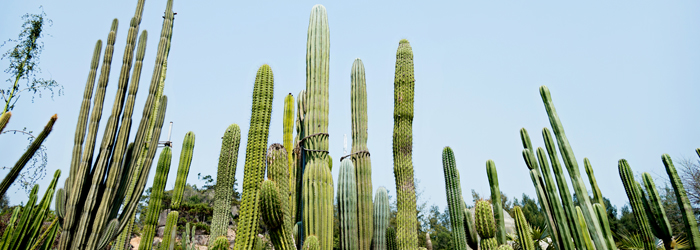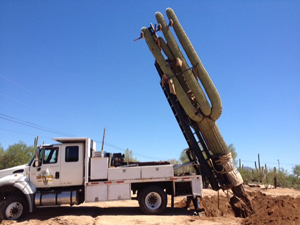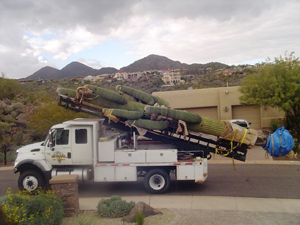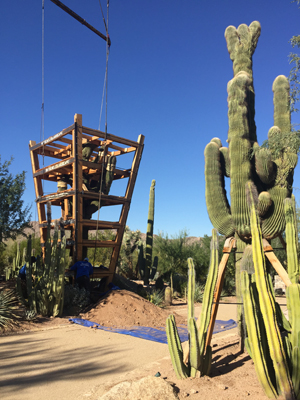All About Saguaros
 25 January 2017
25 January 2017 

Six Questions Often Asked About Saguaros
Nothing says you’re in Arizona better than those silhouettes of saguaros set against a red sky at sunset. After all, the National Park Service says, saguaros mostly grow in the Sonoran Desert. That means that almost all the wild ones grow in Arizona and some smaller areas of Mexico and California.
Often during the Rosie on the House broadcast we get questions from homeowners who have saguaros in their yards or want to plant a saguaro. Here are six things you may want to know about them as well:
1 | Can I dig up my saguaro and get rid of it?
Other versions of this question: Can I give my saguaro to my neighbor? Do I need a permit to remove the saguaro from my yard? Can I sell my saguaro? I could use the cash!
You probably know that saguaros are native plants that have state protection. According to the Arizona Department of Agriculture, you as a landowner have the right to destroy or remove any plant on your land. However, with native saguaros, you must notify the department first. You also have the right to sell or give away any plant on your lot, but if you're transporting the cactus somewhere else, you will need a permit and a tag; the price of both together is around $20. You don't want to forget the permit or you may end up being fined. If you're hoping to sell a saguaro to a plant dealer, by the way, it needs to be in almost perfect condition.
Arizona Department of Agriculture Resources:
- More Information, Native Plant Removal Procedures, Landowners' Rights, Permit, Seal & Tag Fees
- Application for Blue Seal Permit (PDF)
2 | What do saguaros cost?
The smaller the saguaro, the less it will cost. But generally, they go for about $100 or more a foot if they are just spears and are in excellent condition. Saguaros with arms are more costly.
3 | I want to add onto my house; can I move a saguaro that’s in the way to elsewhere in my yard?
If you’re just moving the saguaro on your own lot, you may not need a permit and tag; but some Arizona cities, like Scottsdale, even require a city permit to move the saguaro on your property.
4 | What are the chances that my saguaro will survive if I move it? And what will it cost to move it?
If you're thinking of moving a saguaro, you need professional help. Ask a nursery that you trust for the name of someone who can do the job. Plant relocation companies say they can move saguaros even when they're very large –20 feet to 45 feet tall, for example, with a taproot that could be 4 feet long. They can even handle cacti with arms.
Keith Price, co-owner of Tree Relocators in Scottsdale says that the success rate for large saguaros is usually 95 percent after they're moved. With shorter cacti, almost 100 percent survive, he says.
 The cost ranges from $20 to $25 a foot for spears; cacti with arms cost more. He moves about 500 cacti per year and has even moved a cactus for homeowners who sold their house and wanted to take the saguaro to their new location.
The cost ranges from $20 to $25 a foot for spears; cacti with arms cost more. He moves about 500 cacti per year and has even moved a cactus for homeowners who sold their house and wanted to take the saguaro to their new location.
For larger saguaros, Keith uses a backhoe to help excavate the cactus and puts it onto a hydraulic ladder with a cradle lined with carpeting.
Aaron Mitschele of Mitschele's Landscape Design in Phoenix creates a box out of lumber to shelter the cactus after taking it from a site. In some cases, he says the cacti are so big that the truck moving the saguaro needs a vehicle escort.
When the saguaro is replanted, it needs the same orientation to the sun that it had in its prior home. There is not a lot of watering that takes place before or afterward because a heavy cactus could topple over if the soil is too soft. Saguaros are temporarily propped up with 2 by 4s or 2 by 6s after a move.
5 | If I buy a really big saguaro that a guy is selling out of a truck parked by the side of the road, will the saguaro survive?
Be super-cautious about buying a saguaro this way. If someone has removed a cactus from a site without using proper equipment, they can crack off the tap root in the process. You can see if this has happened by inspecting the roots. You also do not want to buy from someone who can’t show you the permit and tag for the cactus.
6 | What about that hole that a bird pecked into my saguaro? Now black junk is leaking out of the hole; will the saguaro survive?
When birds peck into saguaros to create a nesting area, the cacti sometimes contract bacterial necrosis, a vascular disease common in saguaros. Typical symptoms include black material that oozes out of lesions or accumulates in bird holes. If you have the damaged area cleaned out and disinfected, sometimes the saguaro can be saved. But if the disease travels through the main trunk of the saguaro, the cactus could die or start to lose arms. Have an expert look at your infected saguaro to see if it can be treated or saved.
###
Photo Credits:
- Removing saguaro: Tree Relocators
- Trasporting saguaro: Tree Relocators
- Transplanting saguaro: Mitschele's Landscape Design
RELATED CONTENT:
- Pruning: What To Do, and What NOT To Do!
- Cactus: How Can I Protect My cactus From Freezing?
- Blog: Plants: Out of Control!
- Podcast: Plants that love Arizona too much!
- Zipcode Search: Rosie-Certified Contractors and Home improvement Service Providers
Print this page
recent post
- Duck, Duck, Duct! How Often Should Ductwork Be Cleaned?
- Vinyl vs. Fiberglass Windows: Which Is The Better Choice Of Replacement Window?
- We May Be The Grand Canyon State, But The Rocky Mountains Are Important For Arizona
- Welcome to Arizona! Things A Newbie to Arizona Should Know
- The Pros & Cons of Buying A Flipped House
- Getting In On The Ground Floor
- Why It’s More Critical Than Ever To Get Your AC Serviced Before Summer
- The Reality of Remodeling
- What To Look For When Comparing Your Roofing Quotes
- What To Expect When Buying New Windows & Doors
